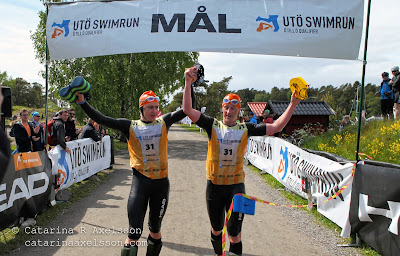Two weeks ago SwimRun rookies Nicolas Remires and Julian Dent were the first team to cross the finish line of the Utö competition. A week later, at the Borås race, not one team was able to catch them again. To find out why an Australian Orienteer and a Frenchman pair up to dip and jog around the Baltic sea, I asked team member Nicolas Remires some questions.
 |
| Picture Credit: www.catarinaaxelsson.com |
RUNssel: You and Julian put on quite a show in the last two weeks. Winning Utö and then Boras a week later. I hope you are tired now!
Nicolas: We are very tired! Especially after Borås.
You stated that you did a course Reece on the island of Utö. Did you do the same for the competition in Boras? What are the key variances amongst the two courses?
As the two of us are living in Stockholm, we didn’t do any reckon for Borås, but I did this race last year and I knew the course quite well. We also spent lots of time studying the map (elevation, distance, nutrition station places).
As both of you been living in Sweden since 4 years, what was your initial thought when you heard about SwimRun?
The last few years I spent some time with multisport and adventure athletes. They all talk about ÖtillÖ. I was looking for a new motivation to train hard again and follow a training plan. Julian is a world class orienteer who can swim. He is my best friend and we thought it was a great adventure as a group.
 |
| Picture Credit: www.catarinaaxelsson.com |
How would you describe the sport of SwimRunning to your training mates back home in France?
I will describe that sport as a real team sport. This is a partnership and friendship adventure. You have to know each other to perform. You have to be strong physically and mentally. The most important thing is to communicate honestly with your partner.
I would also describe it as a single activity sport (it is not an aquathlon or a swim and a run). You have to find the perfect pace in the water and on land to stay steady and strong during the full length of the course.
In France there were already a few articles in our sport magazines in the last few years. In my local area, I have been running with my wetsuit and swimming with my shoes last year and my athlete friends are still a bit sceptical. But I’m sure it will evolve. I hope we will see some SwimRun races in France soon. In Australia, I didn’t hear anything yet, but I’m sure some great endurance athletes will start something soon.
From triathlon to mountain running, road cycling, MTB and ski mountaineering, you have done all sorts of endurance sports. What made you try this one and what is the one-off factor with this activity?
I needed a new challenge. I never managed to do the same activity too long. What really attracted me is to go from one place to another one, carrying your gear and staying close to your partner. The Stockholm Archipelago is stunning, so going from one island to another one is a great challenge in itself.
 |
| Picture Credit: www.catarinaaxelsson.com |
What was the best advice you have been given?
The best advice given to me was to never stop. Always move forward even when you are at the drink stations.
Now, after two fruitful jaunts, if you would give away one tip to another team, what would it be?
I would recommend the following points:
– Spend time training with you partner. It is important to figure out the best settings, especially for the swimming.
– Run in the forest, because in many of these races, there are some technical sections and you can lose a lot of time or injure yourself.
– Get used to run after swimming (especially in cold water). Your body has to be ready to switch from swimming mode (breathing, kicking) to running.
Leading up to this season, how did a normal training week look like for you guys?
We are running almost every day (as much as possible in the forest). I have been swimming 4-6 times a week following the plan of our great Italian coach Luca Mazzurana. We are trying to increase the distance in both disciplines the closer we get to ÖtillÖ.
The last 4 weeks before the first race on Utö island was also important to get used to the water temperatures and to use the specific racing equipment.
Via merit selection you guys are already qualified for ÖtillÖ. How will you approach the build-up and the race?
For the preparation, we have 3 months to get ready to race the distance. It is a big challenge. We will spend this time discovering our 8h race pace in the water and on land. The training block on the ÖtillÖ course is starting this week. We will increase the training durations and also try to recover a lot between the long sessions.
Anything else I should know? Any individual competitions coming up? What is next for you?
For me it is 3 months of training in the Stockholm area but also in France for 4 weeks. Julian has a few orienteering races planned. We will race the Ångalöppet in August then finally ÖtillÖ. Full focus on some proper training now.
 |
| Picture Credit: www.catarinaaxelsson.com |

